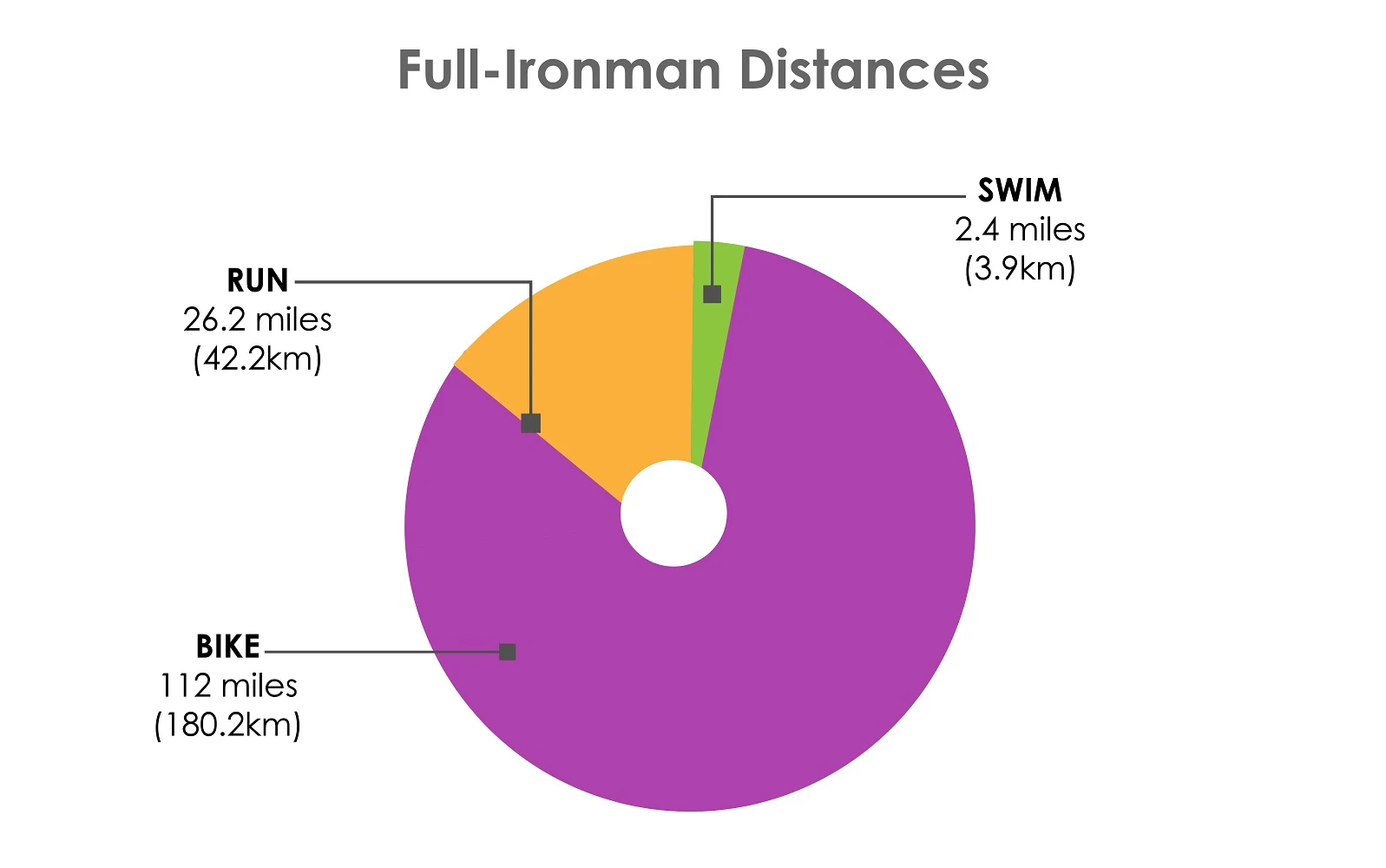
How Long is an Ironman Swim, Bike, and Run?
In the world of endurance sports, the full Ironman distance triathlon is an iconic pinnacle that attracts both age groupers and world-class professionals alike.
Whether as a bucket list item or a lifestyle, finishing the entire length of an Ironman triathlon is an all-day endeavor at every fitness level. The three disciplines in succession tout the Ironman as one of the most difficult single-day sporting events in the world.
With a total combined length of 140.6 miles (or 226.3 kilometers) for the full race, the Ironman distances of each discipline include:
- 2.4-mile (3.9km) Swim
- 112-mile (180.2km) Bike
- 26.2-mile (42.2km) Run

Need help training for an Ironman distance triathlon? Utilize our triathlon training plans or find an Ironman coach to help guide your program.
Ironman: The Upper-Echelon of Endurance

The Ironman distance of triathlon is considered the upper echelon of multisport racing. Completing such distances requires a high level of fitness, endurance, and mental resilience.
Triathletes undergo anywhere between 8 hours for top professionals to 16+ hours for age groupers, with the average Ironman finishing time a little over 12 hours.
In the last several years, the fastest Ironman times have been sharply dropping. A sub-8-hour Ironman for the elite men is not uncommon, and the women’s field is literally minutes away from achieving this.
Learn more below about the fastest (and the average) Ironman finish times, cutoff times, and what to expect when going the length of an Ironman triathlon.
Fastest Ironman Times

The Evolution of the Sub-8-Hour Ironman
The fastest Ironman times have progressed rapidly over the years. In 2017, Tim Don set the record for the full Ironman distance when he finished Ironman Brazil with a time of 7:40:23.
But four years later, in 2021, the record was broken twice. First, in July 2021, by Jan Frodeno at Tri Battle Royal with a time of 7:27:53, and again in November by Kristian Blummenfelt. It was at Ironman Cozumel where Kristian Blummenfelt completed the all-time fastest Ironman finisher time in 7:21:12, shaving over six minutes off the record time.
Blummenfelt’s Ironman record was disputed due to a favorable, down-current ocean swim, which provided a significant advantage in both speed and energy efficiency. Despite this, Blummenfelt was ultimately awarded “world’s best” time for the Ironman distance at the time.
The bar was set even higher at Challenge Roth in 2024, where Denmark’s Magnus Ditlev posted 7:23:24, breaking his own previous year’s record at the same race. While not an official Ironman-branded event, Ditlev’s time currently stands as the fastest iron-distance performance on a fair, standard course.
Progression in the Women’s Field

In 2023, Daniela Ryf shattered the women’s Ironman world record at Challenge Roth with a time of 8:08:12. This broke the 12-year running record that was held by Kona legend and Ironman Hall of Fame inductee Chrissie Wellington, who completed Challenge Roth in 2011 with a time 8:18:13.
However, in 2024, Germany’s Anne Haug pushed the record even further at Challenge Roth, posting a time of 8:02:38. This marked the first time a woman broke the 8:03 barrier at an iron-distance race.
At the 2025 Ironman World Championship in Kona, Norway’s Solveig Lovseth won her debut at the event with a time of 8:28:27 in challenging conditions. British athlete Kat Matthews set a new Kona run course record of 2:47:23 while finishing second, breaking the previous record of 2:48.
These accomplishments from the female field trend toward a sub-8-hour Ironman record in the not-too-distant future.
What’s the Average Finisher Time for Ironman Distance?

For age groupers, good finishing times on moderately difficult courses can range between 9 and 12 hours. But for busy triathletes who are unable to approach their training as a part-time job, the finishing times generally average between 12 and 15 hours.
Overall, the average Ironman time across all age groups is approximately 12 hours and 35 minutes to 12 hours and 49 minutes, depending on the dataset. For men, the average Ironman finishing time is 12 hours and 38 minutes, while for women, it is 13 hours and 35 minutes.
The average swim time is approximately 1 hour and 16 minutes to 1 hour and 20 minutes across both genders. The bike leg takes the longest at an average of 6 hours and 19 minutes to 6 hours and 25 minutes, representing about 50% of the total race time. The marathon run averages 4 hours and 50 minutes to 4 hours and 54 minutes, making up roughly 40% of the overall time.
Ironman Cut-off Times & What It Means

If you’re looking to do your first Ironman, it’s important to be aware of the cut-off times for each leg of the race. Cut-off times may vary depending on the governing body hosting the race, but for Ironman-sanctioned events, they include:
- Ironman Swim Cut-off Time: 2 hours, 20 minutes after the start
- Ironman Bike Cut-off Time: 10 hours, 30 minutes after the start (swim plus bike combined)
- Ironman Run/Finish Cut-off Time: 17 hours after the start
Some Ironman races have stricter cutoff times based on course logistics and road closures. For example, Ironman Vitoria has a cutoff time of just 15 hours and 40 minutes, while other races like Ironman Copenhagen finish at 15 hours and 45 minutes.
These cut-off times are primarily designed for the safety of participating athletes. But they also ensure a smooth-running race where the waters and roads of the course are only blocked off for so long, respecting the cities and communities hosting the event.
If you miss any cutoff time during the race, you will not be allowed to continue to the next segment and will receive a DNF (Did Not Finish). Athletes should always consult the specific athlete guide for their race, as intermediate cutoffs at certain aid stations or course locations may also apply.
Ironman Distance vs. Half-Ironman Distance (70.3)

In most cases, half-Ironman triathlons are more approachable race lengths for amateurs and age-grouper athletes, as the level of commitment and training substantially escalates for full Ironman triathlons.
For most triathletes, the preparation to swim over 2 miles, bike over 100 miles, and run a marathon is a massive undertaking. Having the proper gear, like an Ironman wetsuit (when allowed), a fast bike, and good shoes are crucial to having a successful race.
Not only is the distance itself intimidating, but the importance of remaining strong and injury-free over such training volumes is a challenge in itself. Factor in family, work, and other life demands, and time allocation for Ironman race training can be a difficult balancing act. In turn, it’s generally recommended to complete a couple of half-Ironman triathlons (or “70.3” races) before leveling up to Ironman.
Racing Ironman Triathlon
In a sport where amateur athletes can race alongside professionals, the Ironman triathlon provides the ultimate multisport experience that comes with a passionate and supportive race community. While on the pro level, there’s extraordinary competition. On the amateur and age-grouper level, there’s tremendous camaraderie and support as most athletes are competing against themselves.

Racing the full Ironman distance requires a long-term commitment to training combined with disciplined time management. Unlike sprint triathlons and Olympic distance triathlon, becoming an Ironman is often a lifestyle.
Even the jump from half-Ironman, or 70.3 racing, to Ironman, is significant, as the sheer volume of the event requires a lot more time and focus to be successful.
Athletes who embrace the distance seek more than just race medals for participating. Full-distance finishers are a special breed of athletes who earn lifetime recognition as coveted “Ironman.”
Interested in Going the Ironman Distance?
Both amateur and professional Iron-distance triathletes often benefit from working with a triathlon coach who can align an athlete’s objectives with the right training plan and coaching support.
Working with an Ironman coach can not only be helpful for motivation and accountability but also provide structured training plans that are custom-programmed to an athlete’s goals, skill level, and lifestyle.
Other Recent Posts
- Beginner 20-week Ironman Training Plan
- Triathlon Watches for Multisport Athletes
- Triathlon Transition Tips: How to Improve Your Speed and Set-Up
- Choosing the Best Triathlon Running Shoes
- Triathlon Bike Tires: Best Options, Size Guide, & FAQs
Endurance athlete, professional off-road cyclist, and avid blogger, Tyler Tafelsky participates in long-course multisport and cycling events. Today, Tyler competes in ultra-distance cycling races at the professional level. Since starting Better Triathlete in 2014, he has been the head of content for the site's editorial team. Learn more about Tyler

